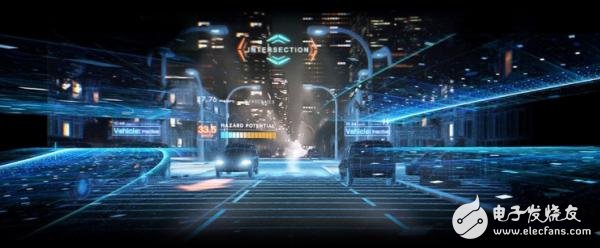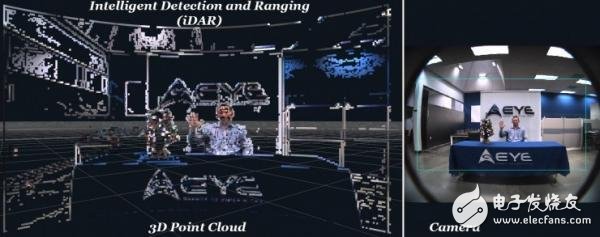AEye officially announced its own iDAR sensor, a new type of smart for self-driving vehicles
Another limitation of traditional lidar is that it cannot provide detailed information on the color and text of the object, so it is impossible to understand the nuances of the color of the target such as road markings, roadsides, road signs and traffic lights, and these tasks require subsequent processing. The challenges of the calibration work are great, there are delays, and it is inevitable to consume computing resources.

As an important sensor for autonomous driving, Lidar (LiDAR) has formed a unique market, which constantly attracts players to join the melee. AEye, a start-up company that started with visual perception, also joined the scuffle, but the company has some "alternative" weapons.
A few days ago, AEye officially announced its own iDAR sensor, a new type of smart sensor for self-driving vehicles that collects data and provides fast dynamic sensing to provide a basis for decision making in vehicle systems. On the upcoming CES 2018, AEye will showcase its demo of the iDAR sensor and release the corresponding self-driving in-vehicle sensor kit.
iDAR, an intelligent LiDARiDAR, the English name is Intelligent DetecTIon and Ranging, the main body is a MOEMS laser radar, which is combined with a low-light camera in advance, and also embedded with artificial intelligence algorithm, real-time perception of the surrounding dynamic environment, its software Can be customized, hardware is scalable. Compared to LiDAR, iDAR sensors provide higher detection accuracy, longer detection distances, and more intelligent sensing information, which will also help optimize the path planning of autonomous vehicles.
According to the official statement, iDAR can significantly improve the safety and performance of autonomous vehicles based on the cost of sensors.
It is understood that iDAR is designed to aggregate pixels (Pixels, 2D) and volume elements (Voxels, 3D) in a frame, so that the efficiency of the system in tracking and defining the target object is improved compared to LiDAR. 10-20 times. In addition, iDAR can also aggregate 2D images and 3D point clouds to detect the true color of an object. At the same time, embedded artificial intelligence can help iDAR use thousands of existing and customized computer vision algorithms, and the system will be smarter when it comes to path planning for autonomous vehicles.
In fact, before the launch of the iDAR sensor, AEye demonstrated its first solid-state laser radar with a horizontal angle of view of 360 degrees in September this year, with a high-resolution range of up to 300m.
Luis Dussan, founder and CEO of AEye, said in an interview with foreign media, "The special architecture designed by AEye for iDAR allows us to overcome many of the fundamental limitations of the first generation of rotating or raster scanning lidar technology."
He explained: "Traditional lidar systems are not intelligent when collecting data. Some of the information that needs to be collected is missed and collected, while some less important data are over-acquired. This also causes traditional lidars to collect data. There are two important indicators of data density and transmission delay, so there is a big limit or even a possibility to do intelligent perception on it. For example, when the traditional 64-line laser radar can be used every 100 milliseconds When an object emits a laser, our iDAR system uses intelligent sensing technology to emit laser light to any selected object. This can be done twice in 30 microseconds, which is 3,000 times faster. Smart optimization optimizes data collection, and we can deliver higher quality, more relevant perceptual content by transmitting smaller amounts of data."
At this stage, AEye is working with a number of OEMs, TIer 1 and university teams based on iDAR sensors to prepare for the integration of iDAR into autonomous vehicles.
What is special about iDAR?Agile lidar

As mentioned above, a big shortcoming of traditional lidar is that there are often over-acquisition or missed mining situations, such as sky, roads, and trees. These are less important information that is often collected by lidar, but for fast approach. Important information such as vehicles is often not available. After that, the system also consumes a lot of processing power and time to distinguish important target objects such as pedestrians, bicycles, motor vehicles and animals.
AEye's iDAR sensor simulates the ability of the human visual cortex to focus on an object and predicts potential driving dangers: it uses a distributed architecture and edge processing system that dynamically tracks the objects and objects of interest, and It scans and judges the overall environment around the self-driving vehicle.
In response to this, AEye Software Director Jon Lareau said, “Humans have the instinct to respond quickly to objects that break into the field of vision, and by integrating smart technology into iDAR to collect data, iDAR will also suddenly appear as humans. The obstacles react. At the same time, iDAR is an open, scalable platform that allows you to effectively combine the performance of a variety of sensors to increase redundancy, improve performance and reduce costs. Most importantly, iDAR can also help Customers streamline the autonomous vehicle development process to bring faster-performing autonomous vehicles to market faster."
True color lidar

Another limitation of traditional lidar is that it cannot provide detailed information on the color and text of the object, so it is impossible to understand the nuances of the color of the target such as road markings, roadsides, road signs and traffic lights, and these tasks require subsequent processing. The challenges of the calibration work are great, there are delays, and it is inevitable to consume computing resources.
The iDAR sensor instantly overlays 2D real-world colors on 3D data and adds them to the 3D point cloud through computer vision technology, avoiding the problems faced by traditional lidars. Therefore, compared to traditional laser radar, iDAR sensor can realize more accurate and high-speed understanding of road signs and various traffic lights, making the whole process smoother.
Software custom and scalable hardware

One of the most notable features of AEye's iDAR sensors is its software-defined and scalable hardware features. Three feedback loops have been added to the iDAR sensor: one at the sensor level and one at the sensing layer; and one with the path planning software. With real-time, customizable data collection, the system adapts to the environment and dynamically changes performance based on the user's application and needs. In addition, it can define areas of interest, focus on threat detection, and program variable environments such as roads or city roads.
This hardware and software configuration optimizes the data collection process, reduces bandwidth, improves visual perception, and quickly develops motion planning for autonomous vehicles.
From basic configuration systems to a variety of customizable systems, users can design iDAR sensor systems through APIs provided by AEye. In addition, iDAR's system architecture allows for remote updates of firmware and software, enabling rapid prototyping without the need to modify hardware.
Attack on AEyeAccording to previous reports, AEye was founded in 2013 and is headquartered in San Francisco to develop advanced machine vision hardware, software and algorithms for autonomous vehicles. AEye released its first solid-state lidar sensor shortly after its establishment, and has since made a series of breakthroughs in IntelliSense technology. In June of this year, AEye completed a $16 million Series A round of financing from a number of capital institutions including Airbus Group and Intel Capital.
Today, AEye combines computer vision, artificial intelligence and laser radar to create a new species, “iDAR,†and how it will change the autonomous driving industry in the future. We can only wait for time to give us the answer.
A business tablet must have powerful business functions. At present, users use tablet products more for entertainment, and insufficient development of commercial value has become a major factor restricting the development of tablet computers. Many far-sighted terminal manufacturers have set their sights on the business tablet field.
Generally speaking, when business users choose tablet PC products, they still focus on "regular items" such as processor, battery, operating system, and built-in applications, especially office software applications, which are a good helper for business users.
First of all, there must be powerful office software such as customer management software, which can record customer data and related information anytime, anywhere. There is also a need for powerful marketing software, software marketing, reducing manual intervention, and one person can handle all the publicity and customer information.
Business Tablet,4k Tablet,5G Tablet
Jingjiang Gisen Technology Co.,Ltd , https://www.jsgisengroup.com
